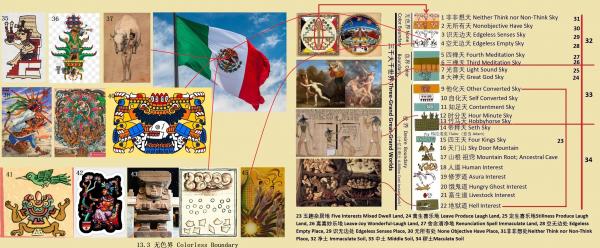| | 无色界有四天,亦作四金刚智;在三界九地的说法中,此四天亦被称作四处或四地。 There are four skies in the Colorless Boundary, also known as Four Philosopher-Stone Intelligences. In the saying of “Three Boundaries Nine Lands”, these four skies are also called the Four Places or Four Lands. 一)空无边处天(注1),谓此天厌于色身系缚,不得自在,心缘虚空,与无色相应,住空处定。不论人中天上,初、二、三、四禅中,但除无想天和五不还天,余修空处定者,若得成就,则命终便生此天。既无色蕴,不可说有方隅处所,唯有微细第六意识,所缘无边虚空,为其处也。寿二万一千大劫。 1) Edgeless Empty Place Sky (1), saying that this sky was satiated with bondages of color body, felt not self-sufficient, so with heart to aggregate empty, and matched with empty, therefore dwelling in the empty place stillness. Regardless of among humans, among skies, or in the first, second, third, or fourth meditation, except for the Thinking-less Sky and the Five No Return Skies, all practitioners of empty stillness, if he or she achieves it, then after-life is born in this sky. Since no color node, should not say that there is location or house. There is only the delicate sixth sense (i.e., consciousness), and the objective is edgeless empty which is its place. Lifespan is 21,000 catastrophes.

注13.3-1,此天的空是无意识(古作神识)默认的空色,例如远处天和地交界处的灰色,那不是日常的灰色,而是无意识用自己默认的灰色来区分天和地的。那么图4中,为什么 “翠玉女惊讶地看着玉米棒子” 可以表现 “空无边处” ?这要说说翠玉女是个什么人。 Annotation 13.3-1, the emptiness of this sky is the default color of emptiness of the unconscious (anciently known as God-sense), for example, the gray color at the junction of the sky and the earth in the distance, that is not daily life gray, but the unconscious uses its own default gray color to distinguish between the sky and the earth. So why, in Figure 4, can "Chalchiuhtlicue amazes at the cornstalks" show the Edgeless Empty Place? It has to say something about what Chalchiuhtlicue is. 墨西哥国旗上的鹰或凤凰代表翠玉女,插图35至44都是翠玉女的肖像。图35表示她是在与世隔绝的集中训练营长大的。图36表示幼年的翠玉女知道自己就是一位摩西,就是制作图15右端那根线的材料,但她对法宝和天眼等一无所知,心中充满了迷惑。图37显示少女时代的翠玉女力气很大,可以徒手杀死野牛,并把它扛回营地。 The eagle or phoenix on the Mexican flag represents Chalchiuhtlicue, whose portraits are shown in illustrations 35 through 44. Figure 35 indicates that she grew up in an isolated, centralized training camp. Figure 36 indicates that as a young girl, she knew that she was a Mexi (a Mose among Moses in Bible), the material from which the thread at the right end of Figure 15 was made, but she knew nothing about juristic treasures and godly eyes, etc., and her mind was filled with perplexity. Figure 37 shows that as a teenager Chalchiuhtlicue was so strong that she could kill a bison with her bare hands and carry it back to camp. 图38、39显示翠玉女自愿为再造太阳神献出生命。图40、41是25-39岁的翠玉女,她的大脑像似天线棒,表示她是文字思维型人,即语音思维型人,是一位行天。图42是和墨西哥结婚后的翠玉女,已经成为了众生之母,是《墨西哥法典》的总编。图43中,翠玉女头顶的是《墨西哥法典》。法典中,她展现出了文学才华,出口成章,语言如从天降(如图44)。书中最杰出的部分之一是《到达方舟》,古墨西哥人是用玉米棒子来表示的,即意思食(参见11.5节《 四食谛》)。 Figures 38 and 39 show Chalchiuhtlicue volunteering her life to recreate the Sun God. Figures 40 and 41 show the 25–39-year-old Chalchiuhtlicue, whose brain resembles an antennae bar, indicating that she is a Word Thinking Pattern person, i.e., Lingual Thinking person, is a Migration Sky. Figure 42 is Chalchiuhtlicue after her marriage to Mexico, having become the mother of all livings, the chief editor of Mexican Codex, which is at top of her head in Figure 43. In the Codex, she showed her literary talent, and her articles were written as if they were falling from the sky (Figure 44). One of the most outstanding parts of Mexican Codex is the "Arrival Ark”, which the ancient Mexicans represented by “corn on the cob” (fig. 45; see Section 11.5 Four Foods Crux), is Mana. 《到达方舟》中所运用的最主要心理学原理就是 “净识害有” ,翠玉女总是运用 “空识” 来清洗(即洗礼、割礼)读者的身心。这就如同说翠玉女是在 “空无边处天” 造出《到达方舟》的,所以古墨西哥人用 “她惊讶地看着玉米棒子” 来表示 “空无边处天” 。 The main psychological principle used in Arrival Ark is that "Immaculate senses harm haves”. Chalchiuhtlicue always uses "empty senses" to cleanse (i.e., to baptize, to circumcise, to mind-wash) readers' bodies and minds. This is like saying that she created the "Arrival Ark" in the "Edgeless Empty Place Sky ", so the ancient Mexicans used "Chalchiuhtlicue amazes at the corn cob" to mean the "Edgeless Empty Place Sky ". 二)识无边处天,谓此天厌虚空无边,于是即舍虚空,转心缘识,以识为处故。不论欲界色界空处,但修识处定成,命终即生此天。唯以微细第六意识,所缘无边心识,为其处也。寿四万二千大劫。 2) Edgeless Senses Place Sky, saying that the sky was bored with Edgeless Empty, so abandoned vague empty, turned heart to aggregate senses, therefore by Edgeless Senses as place. Regardless of desire boundary, color boundary, or empty place, as long as cultivated the Senses Place Stillness, after-life is born in this sky. Only the subtle sixth sense, those objectives are edgeless heart senses, which are the place. Lifespan is 42,000 catastrophes. 三)无所有处天,谓此天厌于识处无边,于是舍识,入无所有处;谓不用前空处识处故。不论欲界、色界、空处、识处,但修无所有处定成,命终即生此天。唯以微细第六意识,所缘非空非色境界,为其处也。其王三昧(注2),名之为乐。寿六万三千大劫。 3) No Objective Have Place Sky, saying that this sky surfeited Edgeless Senses Place, so abandoned Senses Place, enters No Objective Have Place; it is said that because he or she does not use the Empty Place and Senses Place. Regardless of the desire boundary, color boundary, empty place, or senses place, as long as successfully cultivates the No Objective Have Place, at end of one’s life, will be born in this sky. Only with little sixth sense, the objective is environment of neither empty nor colorless, which is its place, is king among Samadhis (2), namely Ho-Ho-Ho (i.e., sounds of laugh). Lifespan is 63,000 catastrophes. 注13.3-2,三昧,即三昧地,是梵语,汉语义为正定,如本章的色界18天,无色界4天就是22种三昧地,即22种正定。 Annotation 13.3-2, Samadhi is a Sanskrit word, and its Chinese meaning is Correct Stillness, such as the 18 skies in color boundary, and 4 skies in colorless boundary, are 22 samadhis, are 22 kinds of correct stillness. 四)非想非非想处天,谓此天居无色界之极顶,非无所有处之无想,非识无边处之有想。唯以极微细第六识,所缘非有非无境界为其处也。不论欲色二界,空等三处,但修非非想处定成,命终即生此天。寿八万四千大劫,居三有(注3)顶,更无可进。 4) Neither Thinking nor Thinking-less Place Sky, saying that this sky is at the top of the colorless boundary, neither thinking-less of “No Objective Have Place” nor thinkings of “Edgeless Senses Place”. Only with the extremely subtle sixth sense, those objectives are environment of neither have nor none, which is its place. Regardless of the desire boundary, color boundary, empty place, senses place, or no objective have place, as long as one achieves the Neither Thinking nor Thinking-less Place Stillness, after-life is reborn in this sky. With a lifespan of 63,000 catastrophes, the sky dwells at top of Three Haves (3), no further to go. 注13.3-3,记忆有,习气有,就是有;因果不忘为有。三有,即13.1节的欲界,13.2节的色界,和本节的无色界;此三界人人都有,故名三有。 Annotation 13.3-3, having memories or having habits is named haves; cause and effect are not forgotten as have. Three Haves, mean that section 13.1 Desire Boundary, section 13.2 Color Boundary, and this section of Colorless Boundary are three haves, because everyone has the three. ↪️返回第13章《苦谛》的目录↪️Back to Catalog of Chapter 13 Bitter Crux
|
